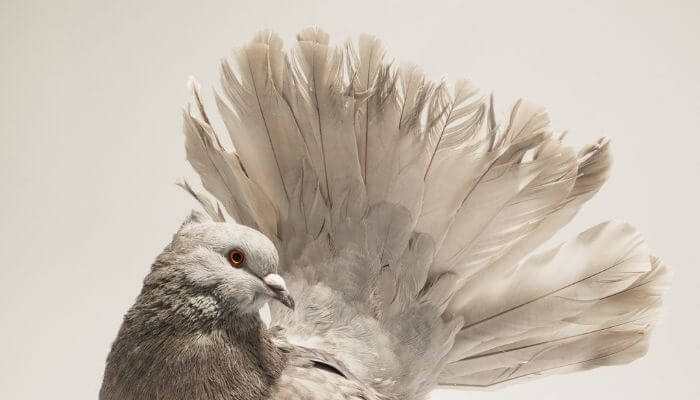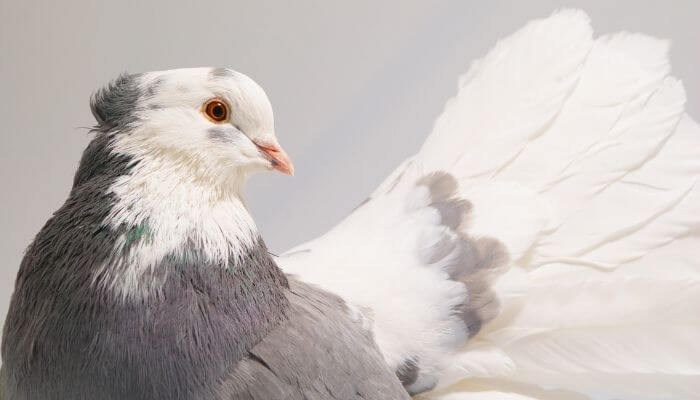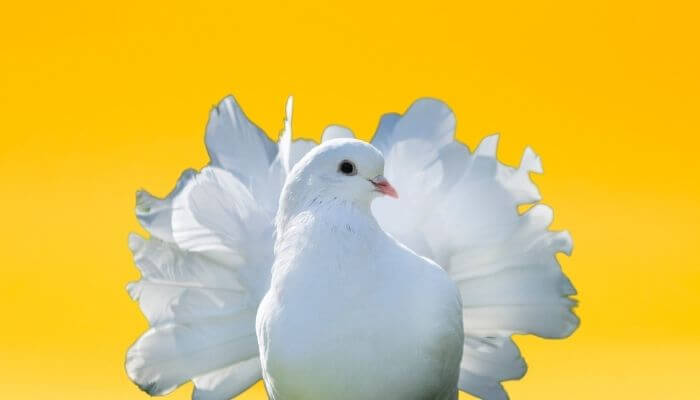A descendant of the rock dove like all pigeons, the Indian Fantail Pigeon is a breed of fancy pigeon.
It was created through careful selective breeding and is a member of the fantail pigeon group.
Indian fantails differ from American fantails, as they are larger and have crests and feathered feet.

Indian Fantail Origins
The result of selective breeding, as their names implies, they have their origins in India.
Fantails are among the oldest of the fancy breeds of pigeon, with them being recorded in Spain as far back as 1150 AD.
The Indian fantail pigeon specifically, dates back to 1560 AD.
There are two classes of fantail pigeons – the Indian and the American.
While fantails originated in India, the original was improved upon by breeders in both the UK and the United States, resulting in two distinct versions of the breed.
Indian Fantail Pigeon Appearance
The most obvious characteristics that make the fantail distinct is the show-off tail that gives the pigeon its name.
The tail has 30 to 40 feathers compared to the standard 12 to 14 feathers seen on most other members of the pigeon family.

The Indian fantail is a medium-sized bird and is usually larger than other fantail breeds. A mature bird weighs between 350 and 380 g and grows to about 28 cm.
The birds walk on their toes, which are covered in feathers and their posture involves holding their chest upright, allowing their heads to rest on the cushion that is formed by their tail feathers.
It gives the pigeon quite a rounded look with the chest seemingly thrust forward and sometimes seeming to be higher than the head.
The Indian fantail also has a crest on its head.
Indian Fantail Colourings
Indian fantail pigeons are most commonly white and tan however, there has been a full spectrum of colours introduced through selective breeding and you might see them in varying shades and hues of these colours including black, red, yellow, blue, silver and dun (a greyish brown).
There are also some Indian fantails with various splashes.
Characteristics
This breed of pigeon is generally mild mannered with a calm and gentle nature.
They are naturally tame and are easy to train.
They’re ideal for raising as pets but are just as easygoing when raising them for show or ornamental reasons. They are tolerant of most climates.
As pigeons go, the Indian fantail has a comparatively long lifespan, living an average of 10 to 20 years.

However, they don’t fly well so it’s important to watch them around potential predators, such as cats and larger birds.
One thing to keep in mind when breeding Indian fantails is their feathers. The tails and feathered feet can interfere with normal behaviour of the pigeons.
That includes feeding, perching, flying, drinking and breeding. It’s important to be sure your pigeons are well cared for since these behaviors may be restricted.
Abnormal feathers can also cause the bird discomfort and frustration so it’s an issue that you need to be aware of.
Breeding Indian Fantail Pigeons
Breeding your Indian fantail pigeons requires patience and care.
Like many animals, you can’t force the breeding process, but there are a number of things you can do to encourage your pigeons to mate.
Potential mates will need a calm environment that enables them to relax and feel comfortable in their surroundings.
Placing the pigeons in a breeding box is one way to get the mating process underway, but a separate pigeon cage is another option.
It is advisable to cut back the tail feathers when trying to breed as they can interfere with the mating process.
Mating behaviors include kissing, cooing, nesting, and eventually mating.
Once mating occurs, the female will lay her eggs about 10 days later. She will then sit on the eggs as she waits for them to hatch.
Indian fantail pigeons usually lay two to three eggs in a clutch and it takes about four to six weeks before the hatchlings fledge.
They are not particularly good parents, so it is sometimes necessary to encourage more maternal/paternal birds to take over the care of the new chicks.
If you love the beautiful feathers of the fantail and are looking for a beautiful and docile bird, the Indian Fantail pigeon may be just what you’re looking for.
Resources:
